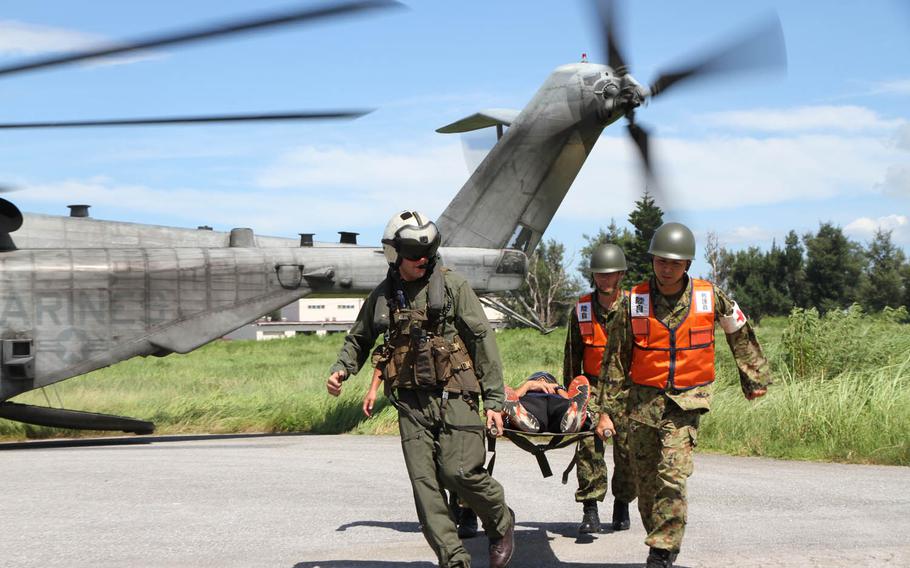
Marine Cpl. Kurt Bokern, left, a CH-53E Super Stallion crew chief from Marine Heavy Helicopter Squadron 361, jumps in and helps his counterparts from the Japan Ground Self-Defense Force as they carry a simulated casualty from the Super Stallion to a waiting ambulance during Japan's annual Churashima Rescue Exercise, Thursday, July 21, 2016. This year marks only the second time the Marines on Okinawa have participated and the first for HMH-361. The exercise is meant to prepare the allied militaries, emergency first responders and even local officials for a mega-disaster similar to the earthquake and tsunami that struck the Tohoku region in March 2011. (Matthew M. Burke/Stars and Strip)
CAMP FOSTER, Okinawa — The Marines further solidified their working relationship with Japan’s military Thursday as preparation for a possible emergency in a country that is prone to disasters.
Participating in Japan’s Churashima Rescue Exercise for the second consecutive year, the Marines used their choppers to set up an aerial ambulance service, shuttling “victims” from a mock disaster. The Marines said it was good to work out the kinks, such as navigating the language barrier, prior to an actual disaster.
“What we’re trying to accomplish is just exercise our relations between us and the Japanese,” said Capt. Jared Howells, a CH-53E Super Stallion pilot.
“So if something does happen — disaster relief or if they just need assistance moving something, or really just training in general — we’ve already established the rapport; we know what kind of constraints both parties have, and what abilities both parties have, and we’ve already had an opportunity to overcome those so we’re not running into barriers the first time doing this.”
The annual exercise — sponsored by the Japan Ground Self-Defense Force’s 15th Brigade, Western Army — is designed to prepare JGSDF troops and Okinawan first responders for a disaster, such as the earthquake and tsunami that rocked mainland Japan in March 2011 and spawned a nuclear disaster.
This year, the Flying Tigers of Marine Heavy Helicopter Squadron 361, who are in the region until November through a Unit Deployment Program rotation, joined in, carrying simulated wounded Okinawans from the central part of the island to waiting medical services at Camp Naha in the south. Marine and JGSDF officials said joint practice is critical since both have bases on Okinawa.
“Okinawa is an island so we have limited resources, especially in case of an emergency,” said JGSDF Master Sgt. Masayoshi Kamoshida, a 15th Brigade liaison with the Marines. “The Okinawan people and all of the involved organizations understand the importance of the ability to respond to an emergency.”
The exercise also involved local police and fire crews as well as the coordination of prefectural authorities, Kamoshida said.
Marine participation began Thursday afternoon when Japanese soldiers arrived at Marine Corps Air Station Futenma in civilian attire. They boarded the Tigers’ CH-53E Super Stallions and headed south for a jostling 20-minute ride.
Howells and Capt. Rob Pfeil, also a pilot, couldn’t escape the searing heat of the cockpit, but Cpl. Sara Duperow, an aerial observer, and Cpl. Kurt Bokern, a crew chief, were able to lean out the open port and starboard windows as gritty sweat poured down their faces. There, they had stunning vistas of Okinawa’s cities as well as its greenish-blue waters and flowering reefs.
When the aircraft touched down at Camp Naha, next to Okinawa’s airport, stretcher-toting JGSDF troops rushed out to greet the Marines, secured their “injured” counterparts and hustled them into a waiting ambulance.
On the last trip, Bokern noticed they were short a man. Forgoing the language barrier, he grabbed the side of a stretcher and lent a hand, then hustled back to the waiting Super Stallion.
The Marines were on the ground for less than 10 minutes. However, seeing how each nation works was invaluable.
As they took off to return to Futenma, their focus shifted to the natural environment.
“I love the scenery,” said Duperow, who is used to training in the desert because the Flying Tigers are stationed at Marine Corps Air Station Miramar. “I got to see a bunch of sea turtles the other day. It’s really beautiful out here.”